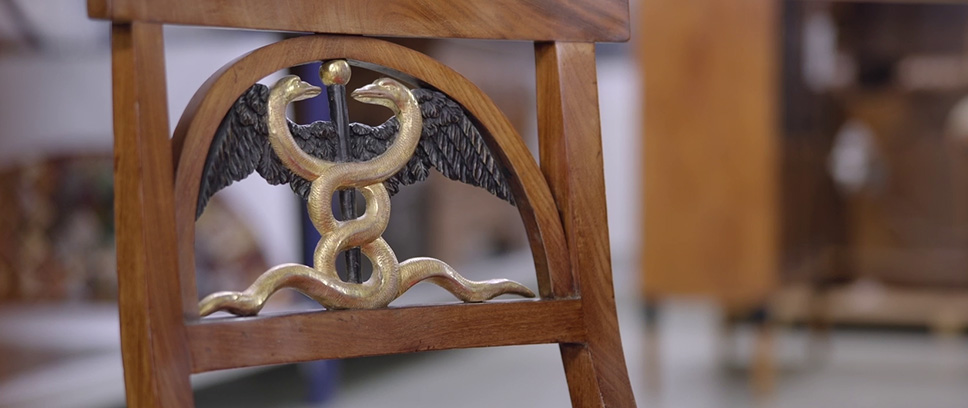
Back to Berlin
Dr Dietmar J. Ponert on an extensive bestowal from a family estate
29 January 2025
The blog series on the collection work of the Deutsches Historisches Museum (DHM) deals with core questions such as the decision for or against the acquisition of certain objects, the different ways in which they are found and acquired, the changing research questions posed by the objects in the collections, the provenance and origin of the objects, and many other aspects.
At the end of 2023 the extensive estate of the Berlin family Bornitz became part of the Collection of Applied Art of the DHM as a private bestowal from Dr Dietmar J. Ponert, former art historian who worked at the Berlin Museum (now: Stadtmuseum Berlin). Ponert spoke about it with Dr Wolfgang Cortjaens.
The estate contains objects made of very different materials, including a dining room seating group from the time around 1810, miniature portraits of family members and their acquaintances, amateur paintings with verdute of various places of residence and activity, hand-painted KPM porcelain, cast iron objects from Berlin of the Schinkel period, and a trio of rare classicistic marble vases mounted in bronze from the time around 1780/90. The objects have stood the test of time.
The centrepiece of the bestowal – an exquisite seating group with mahogany and palisander veneer – originally stood in the classicistic town house of Gräfin von Schmettow, Unter den Linden 16. From 1810 on, Friedrich Bornitz (1777–1853), a physician who worked at the Charité, lived there with his family on the ground floor. The objects were inherited by his son Friedrich Alexander (1809–1876), who held the post of pastor in Stralau from 1845 until his death and lived in the parsonage in Berlin-Lichtenberg, which still stands today.
Towards the end of the century, the estate of Pastor Bornitz described above came to the Pfannenstiel family through the marriage the pastor’s daughter and heir, Alexandrine Wilhelmine Johanne, to Johann Friedrich Hermann Pfannenstiel (1829–1896). His grandson Ekkehart Pfannenstiel (1896–1986) became the intellectual mentor of the now 81-year-old donor Dietmar J. Ponert, whose family fled from Breslau in 1945 and later lived in Oldenburg (Lower Saxony): “During my schooltime at the ‘Altes Gymnasium’ in Oldenburg I was often invited to the living room, which was furnished with these pieces of furniture, pictures and objects, which were saved during and after the war at many stations along the way and with many things lost until they finally arrived here. I, too, was a ‘refugee’, born in Breslau in 1943 and fled in January 1945 with my mother and her parents on an “oxen trek” to the Bavarian forest and grew up from 1946 on in Oldenburg. I am now able to reconstruct parts of the life history of the music teacher Ekkehart Pfannenstiel, who never told me the story himself.” Dietmar J. Ponert wrote this in a yet unpublished essay on the “Bornitz estate”, which was entrusted to him in the Pfannenstiel testament. With the transfer of the estate to the DHM the circle is now closed and the objects have returned to Berlin within a few hundred metres of their original resting place. Reason enough to invite the generous donor to an interview, which Dietmar J. Ponert was pleased to grant in view of his deep attachment to the objects that had been preserved for so long in his own home, maintained in exemplary fashion, and thoroughly documented through his own research.
Dr Wolfgang Cortjaens, head of the DHM collection of applied art and graphics, and Dr Dietmar J. Ponert, doner of the estate, in conversation.